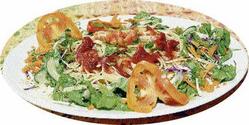
Rosalee Brown
The public is bombarded with many eating plans which aim to help them improve their health. One such plan, which is worth its grain of salt, is the DASH eating plan - the Dietary Approaches to Stop Hypertension.
The final result of the DASH clinical study, published in the New England Journal of Medicine in 1997, was funded by the National Heart Lung and Blood Institute of the United States of America and the diet has been shown to lower high blood pressure. It is rich in fruits, vegetables, grains, low-fat dairy and low in saturated, cholesterol and total fat.
It is a good source of fibre, potassium, magnesium and calcium and provides adequate amounts of proteins. In the DASH diet, a large proportion of the protein is from legumes. I can hear many persons asking what is new about this plan, maybe nothing, as the foods are not new, but the result lies in consistency.
More fruits and veggies
Changing our lifestyle, which means consuming these foods daily or on a regular basis, is difficult for many persons. Many persons still find it very difficult to consume four to five servings of vegetables per day. This increase in vegetables allows you to reduce excess consumption of grains, cereals and ground provisions which is effective for persons seeking to consume fewer calories. Increasing fruits in the diet can replace sweet snacks and other high-calorie options craved in between meals. Nuts and seeds are not only a good source of healthy fats and proteins but, when eaten in moderation, can contribute to improved health.
The mantra 'the race is not for the swift, but he who endures to the end' is true in this instance, as new findings are suggesting that not only does the DASH reduce high blood pressure but has great benefits for women who adhere to it for a long time. Middle-aged women in the Nurses' Health study followed up for 24 years women showed lower levels of stroke and coronary heart disease. Fung et al, from the Harvard School of Public Health, found a 24 per cent reduction in coronary heart disease and an 18 per cent reduction in strokes in those women whose eating styles were consistently like the DASH.
Watch your portions

Make mealtime a colourful experience as this serving of Ashanti pasta with an assortment of vegetables from the Ashanti Restaurant. - Ricardo Makyn/Staff Photographer
Persons who want to prevent and control high blood pressure and reduce their risk of coronary heart disease and stroke should change their priority a little by repositioning the types of foods and the proportion on their plates.
Tips
Increase vegetables of all colours.
Increase legumes and nuts and reduce animal proteins.
Have more whole fruits.
Replace processed grains and cereals with unprocessed varieties.
In general have smaller portions.
Reduce sugars, fats and sodium.
High-priced veggies
The price of vegetables is high at this point in time but you have to, however, make a choice in the interest of your health. If you are unable to back yard or container garden then you have to reduce the spending on items which are unfriendly to health in order to afford more of the healthier choices. You will agree that the benefits are too great to ignore but it seems to be for the tortoise who sticks to the trail!
Rosalee M. Brown is a registered dietitian/nutritionist who operates Integrated Nutrition and Health Services; email: yourhealth@gleanerjm.com.

